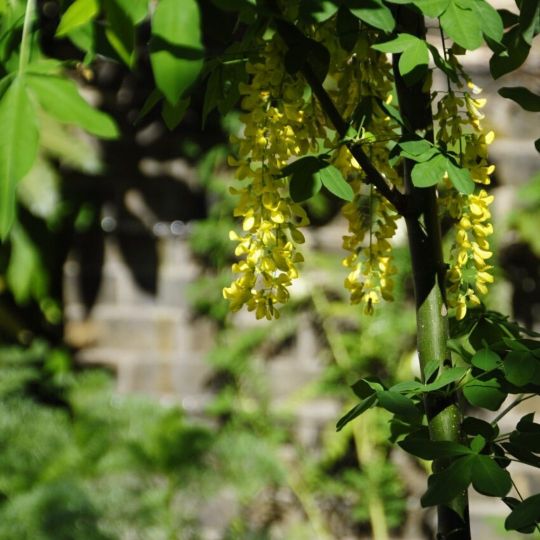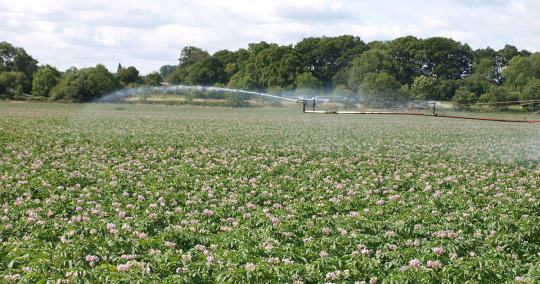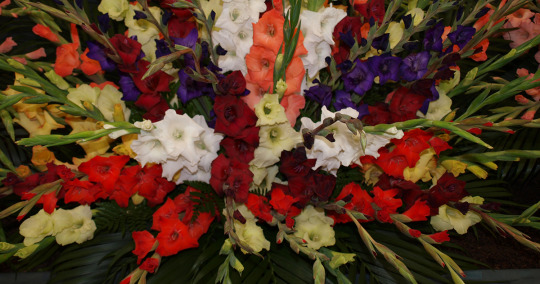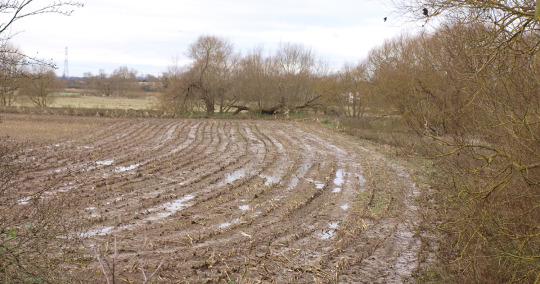#iyph2020
Another month starts in the SCIence Garden with no visitors to appreciate the burgeoning growth of fresh new leaves and spring flowers, but that doesn’t mean we should forget about it!
Hopefully in our absence the Laburnum tree in the garden, Laburnumxwatereri‘Vossii’ will be flowering beautifully, its long racemes of golden yellow flowers looking stunning in the spring sunshine!

Laburnum x watereri ‘Vossii’ in the SCIence Garden
This particular cultivar originated in the late 19th century in the Netherlands, selected from the hybrid species which itself is a cross between Laburnum alpinum andL. anagyroides. This hybrid species was named for the Waterers nursery in Knaphill, Surrey and was formally named in a German publication of 1893 (Handbuch der Laubholzkunde, Berlin 3:673 (1893)

The laburnum tree is found very commonly in gardens in the UK, and is noticeable at this time of year for its long chains of golden yellow flowers. However, the beautiful flowers hide a dark side to this plant. The seeds (and indeed all parts) of the tree are poisonous to humans and many animals. They are poisonous due to the presence of a very toxic alkaloid called cytisine (not to be confused with cytosine, a component of DNA). Cytisine has a similar structure to nicotine (another plant natural product), and has similar pharmacological effects. It has been used as a smoking cessation therapy, as has varenicline, which has a structure based on that of cytisine. These molecules are partial agonists at the nicotinic receptor (compared to nicotine which is a full agonist) and reduce the cravings and “pleasurable” effects associated with nicotine.

Cytisine is found in several other plants in the legume family, including Thermopsis lanceolata, which also looks stunning in early summer and Baptisiaspecies, also growing in the SCIence Garden and flowering later in the year.

In 2018 there were 9.6 million deaths from cancer and 33% of these were linked to exposure to tobacco smoke.* Since the link between smoking and lung cancer was established in 1950, the market for smoking cessation therapies has increased enormously. In 2018 it was worth over 18 billion dollars annually worldwide and is projected to increase to 64 billion dollars by 2026.** Staggering! Varenicline, sold under the brand names Champix and Chantix, is one of the most significant smoking cessation therapies apart from nicotine replacement products.
If you see a laburnum tree whilst out on your daily allowed exercise this month, have a thought for its use as a smoking cessation therapy!
* Data from the Cancer Research UK website https://www.cancerresearchuk.org/health-professional/cancer-statistics/worldwide-cancer#heading-Zero accessed May 2020.
Written by Alison Foster: Botanical Horticulturist and Science Communicator
Seed is one of Nature’s tiny miracles upon which the human race relies for its food and pleasure.

Cabbage seed
Each grain contains the genetic information for growth, development, flowering and fruiting for the preponderant plant life living on this planet. And when provided with adequate oxygen, moisture, warmth, light, physical support and nutrients germination will result in a new generation of a species. These vary from tiny short-lived alpines to the monumental redwood trees growing for centuries on the Pacific west coast of America.
Humankind has tamed and selected a few plant species for food and decorative purposes.

Seed head of beetroot, the seeds are in clusters.
Seed of these, especially food plants, is an internationally traded commodity. Strict criteria governed by legal treaties apply for the quality and health of agricultural and many horticultural seeds. This ensures that resultant crops are true to type and capable of producing high grade products as claimed by the companies who sell the seed.
Companies involved in the seed industry place considerable emphasis on ensuring that their products are capable of growing into profitable crops for farmers and growers. Parental seed crops are grown in isolation from farm crops thereby avoiding the potential for genetic cross-contamination. With some very high value seed the parent plants may be grown under protection and pollinated by hand.
Samples of seed are tested under laboratory conditions by qualified seed analysts. Quality tests identify levels of physical contamination, damage which may have resulted in harvesting and cleaning the seed and the proportion of capable of satisfactory germination. There may also be molecular tests which can identify trueness to type. Identifying the healthiness of seed is especially important. The seed coat can carry fungal and bacterial spores which could result in diseased crops. Similarly, some pathogens, including viruses, may be carried internally within seed.

Septoria apicola – seed borne pathogen causing late blight of celery
Pests, especially insects, find seed attractive food sources and may be carried with it. Careful analytical testing will identify the presence of these problems in batches of seed.
The capabilities of seed for producing vigorous plants is particularly important with very high value vegetable and salad crops. Vigour testing is a refined analytical process which tracks the uniformity and speed of germination supplemented with chemical tests determining the robustness of plant cells. Producers rely on the quality, uniformity and maturity rates of crops such as lettuce, green broccoli or cauliflower so they meet the strict delivery schedules set by supermarkets. Financial penalties are imposed for failures in the supply chain.
Biology’s seemingly inert tiny seed grains are essential ingredients of humankind’s existence!
Written by: Professor Geoff Dixon, author of Garden practices and their science (ISBN 978-1-138-20906-0) published by Routledge 2019.
Transferring plants between countries was a profitable source for novel commercial and garden plants until quite recently.

Potato crop: Geoff Dixon
Potatoes and tomatoes are classic examples arriving in Europe from South America during the 16th century. Substantial numbers of new plants fuelled empire expansion founding new industries such as rubber and coffee. One of the earliest functions of European botanic gardens was finding potentially valuable new crops for colonial businesses. At home selecting orchids and other exotics from imported plants brought fame and fortune for head gardeners managing the large 19th century estates such as Chatsworth. Commercially seed merchants selected by eye and feel new and improved vegetables, fruit and flowers.
The rediscovery of Mendel’s laws of inheritance brought systematic science and formalised breeding new crops and garden plants. Analysing the effects of transferring physical, chemical and biological characters identified gene numbers and their functions.

Colour range in Gladioli: Geoff Dixon
As a result, varieties with improved colourfulness, fruitfulness, yield and pest and pathogen tolerance fill seedsmen’s catalogues. Breeding increased food supplies and added colour into the gardens springing up in suburban areas as affluence increased.
Greater plant reliability and uniformity arrived with the discovery of F1hybrids.

Hybrid Sunflowers: Geoff Dixon
Selected parental lines each with very desirable characters such as fruit colour are in-breed for several generations. Then they are crossed bringing an explosion of vigour, uniformity and reliability (known as heterosis). Saving seed from the hybrid lines does not however, perpetuate these characters; new generations come only from remaking the original cross. That is a major boon for the breeder as competitors cannot pirate their intellectual property.
Knowledge at the molecular level has unravelled still further gene structure and functioning. Tagging or marking specific genes with known properties shortens the breeding cycle adding reliability and accuracy for the breeder. Simplifying the volume of genetic material used in crosses by halving the number of chromosomes involved adds further precision and control (known as haploidisation).
Opportunities for breeding new plants increases many-fold when advantageous genes are transferred between species. Recent developments of gene-editing where tailored enzymes very precisely snip out unwanted characters and insert advantageous ones is now offering huge opportunities as a non-transgenic technology. Breeding science makes possible mitigation of climate change, reducing for example the impact of soil degradation brought about by flooding.

Flood degraded land: Geoff Dixon
Written by: Professor Geoff Dixon, author of Garden practices and their science (ISBN 978-1-138-20906-0) published by Routledge 2019.
Single plant cells have amazing capacities for regenerating into entire plants. This property is known as ‘totipotency’ discovered in the 1920s. Linking this with increasing understanding of growth control by plant hormones resulted in the development of the sterile, in vitro, culture. Tiny groups of cells, explants, are cut from the rapidly growing tips of shoots in controlled environments and washed in sterilising agents. These are cultured sterile jars containing a layer of agar supplemented with nutrients and hormones.

Green plantlets growing on sterile agar
The process is known as ‘tissue culture’ or micropropagation. As the cells divide and multiply, they are transferred through a series of sterile conditions which encourage root formation.

Roots growing from newly developing plantlets
Ultimately numerous new whole plants are generated. At that point they are removed from sterile conditions and weaned by planting into clean compost in high humidity environments. High humidity is essential as these transplants lack the protective coating of leaf and stem waxes which prevent desiccation. Ultimately when fully weaned the plants are grown under normal nursery conditions into saleable products.
Why bother with this processes which requires expensive facilities and highly skilled staff? A prime advantage is that micropropagated plants have genotypes very closely similar to those of the original parent, essentially they are clones. As a result vast numbers of progeny can be generated from a few parents preserving their characteristics. That is particularly important as a means of bulking-up newly bred varieties of many ornamental and fruit producing plants which otherwise would be reproduced vegetatively from cuttings or by grafting and budding onto rootstocks. Micropropagation is therefore a means for safeguarding the intellectual property of plant breeding companies.
Explants cut from parent plants before culturing can be heat-treated as a means of removing virus infections. The resultant end-products of rooted plants are therefore disease-free or more accurately disease-tested. These plants are usually more vigorous and produce bigger yields of flowers and fruit. Orchids are one of the crops where the impact of micropropagation is most obvious in florists’ shops and supermarkets.

Orchids have benefitted greatly from micropropagation
Large numbers of highly attractive orchids are now readily available. Previously orchids were very expensive and available in sparse numbers.
The world is not perfect and there are disadvantages with micropropagation. Because the progeny are genetically similar they are uniformly susceptible to pests and pathogens. Crops of clonal plants can be and have been rapidly devasted by existing and new strains of insects and diseases to which they have no resistance.
Written by: Professor Geoff Dixon, author of Garden practices and their science (ISBN 978-1-138-20906-0) published by Routledge 2019.
